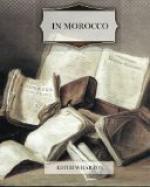Until a year or two ago, the precincts around Moulay Idriss and El Kairouiyin were horm, that is, cut off from the unbeliever. Heavy beams of wood barred the end of each souk, shutting off the sanctuaries, and the Christian could only conjecture what lay beyond. Now he knows in part; for, though the beams have not been lowered, all comers may pass under them to the lanes about the mosques, and even pause a moment in their open doorways. Farther one may not go, for the shrines of Morocco are still closed to unbelievers; but whoever knows Cordova, or has stood under the arches of the Great Mosque of Kairouan, can reconstruct something of the hidden beauties of its namesake, the “Mosque Kairouan” of western Africa.
Once under the bars, the richness of the old Moorish Fez presses upon one with unexpected beauty. Here is the graceful tiled fountain of Nedjarine, glittering with the unapproachable blues and greens of ceramic mosaics, near it, the courtyard of the Fondak Nedjarine, oldest and stateliest of Moroccan inns, with triple galleries of sculptured cedar rising above arcades of stone. A little farther on lights and incense draw one to a threshold where it is well not to linger unduly. Under a deep archway, between booths where gay votive candles are sold, the glimmer of hanging lamps falls on patches of gilding and mosaic, and on veiled women prostrating themselves before an invisible shrine—for this is the vestibule of the mosque of Moulay Idriss, where, on certain days of the week, women are admitted to pray.
Moulay Idriss was not built over the grave of the Fatimite prophet, first of the name, whose bones lie in the Zerhoun above his sacred town. The mosque of Fez grew up around the tomb of his posthumous son, Moulay Idriss II, who, descending from the hills, fell upon a camp of Berbers on an affluent of the Sebou, and there laid the foundations of Fez, and of the Moroccan Empire.
[Illustration: From a photograph from the Service des Beaux-Arts au Maroc
Fez—the Nedjarine fountain]
Of the original monument it is said that little remains. The zaouia[A] which encloses it dates from the reign of Moulay-Ismael, the seventeenth-century Sultan of Meknez, and the mosque itself, and the green minaret shooting up from the very centre of old Fez, were not built until 1820. But a rich surface of age has already formed on all these disparate buildings, and the over-gorgeous details of the shrines and fountains set in their outer walls are blended into harmony by a film of incense-smoke, and the grease of countless venerating lips and hands.
[Footnote A: Moslem monastery.]
Featureless walls of mean houses close in again at the next turn; but a few steps farther another archway reveals another secret scene. This time it is a corner of the jealously guarded court of ablutions in the great mosque El Kairouiyin, with the twin green-roofed pavilions that are so like those of the Alhambra.




